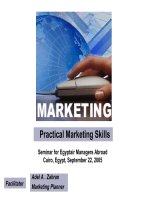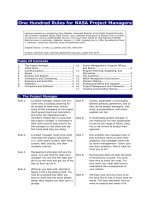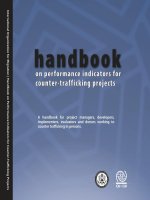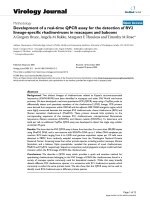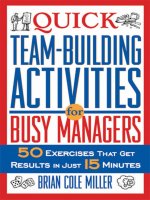Quick Team-Building Activities for Busy Managers: 50 Exercises That Get Results in Just 15 Minutes_7 doc
Bạn đang xem bản rút gọn của tài liệu. Xem và tải ngay bản đầy đủ của tài liệu tại đây (264.41 KB, 19 trang )
INDEX TOWERS
This is . . . A building activity in which participants use index
cards to create a tower.
The purpose The group can find creative ways to overcome adver-
is . . . sity and be successful, even when changes seem to
create problems.
Use this
➤ The group is experiencing lots of change at work.
when . . .
➤ Individuals need to be creative about finding effi-
ciencies despite constant change.
➤ Individuals would benefit from a shot of com-
petitiveness.
Materials
➤ A yardstick or tape measure.
you’ll
➤ 50 index cards for each team.
need . . . ➤ A roll of tape for each team.
➤ Small prizes for the winning team (optional).
Here’s 1. Divide the group into teams of three to five.
how . . . 2. Give each team 25 index cards and a roll of tape.
3. Each team has 5 minutes to build the tallest free-
standing structure possible, using only the mate-
rials provided.
4. The structure must stand long enough for you to
measure it.
5. After you measure all structures, have the teams
destroy them.
6. Announce that you have found that the tape vio-
lates health laws and must be forfeited.
102
QUICK TEAM-BUILDING ACTIVITIES FOR BUSY MANAGERS
miller chap 06 7/24/03 3:43 PM Page 102
7. Now give each team 25 more index cards.
8. Each team has 5 minutes to build the tallest free-
standing structure using only the materials pro-
vided (the 25 new index cards).
9. Measure the structures and determine the tallest.
Ask these ➤ How did you decide on the structure to build each
questions . . . time?
➤ How did you feel when I removed the tape?
(Despair, challenged, frustrated, etc.)
➤ What ways did you find to be successful in the
second round? (Cooperated more, found better ways
to stack the cards, etc.)
➤ What implications does this activity have for us
back on the job?
Tips for ➤ Most teams will find a way to build an even taller
success . . . structure without the tape. If they do not, ask if
they think that eventually they could do so (given
more time to practice or strategize).
➤ Colored index cards invite the team to aim for
aesthetics as well as function.
➤ Be very careful approaching the structures to mea-
sure. You don’t want to create a slight draft that
topples their hard work!
Try these ➤ Start with staplers instead of tape.
variations . . . ➤ When you take the tape away, replace it with sta-
plers for round 2. Sometimes it is not so obvious
whether change is good or bad.
➤ Have a third round in which you increase the
number of index cards given to the teams or
include some larger index cards. Some change
is actually good.
➤ Make the activity go faster by reducing the num-
ber of index cards you distribute and then by
reducing the time you give them to work.
QUICK TEAM-BUILDING ACTIVITIES FOR BUSY MANAGERS 103
miller chap 06 7/24/03 3:43 PM Page 103
MACHINES
This is . . . An activity in which participants create a human
machine and then have to change the machine per
the customer’s request.
The purpose Participants learn that changes can create opportunity
is . . . for improvement.
Use this
➤ The group is experiencing lots of change at work.
when . . .
➤ Individuals need to be creative about finding solu-
tions during change.
➤ You don’t have prep time and/or materials for any-
thing more elaborate.
Materials
➤ No materials are necessary for this activity.
you’ll
need . . .
Here’s 1. Divide the group into teams of 6–10.
how . . . 2. Give each team 6 minutes to plan a human machine.
All participants must be a part of this machine.
3. Watch each team demonstrate its machine
4. Then, select a participant from each machine. An-
nounce that these “machine pieces” are obsolete.
5. The teams now have 3 more minutes to adjust or
reinvent their machines using their selected partic-
ipant in a new way.
Ask these ➤ How did you decide on the machine design?
questions . . .
➤ How did you handle disagreements in the team?
104
QUICK TEAM-BUILDING ACTIVITIES FOR BUSY MANAGERS
miller chap 06 7/24/03 3:43 PM Page 104
➤ How did you feel when I rejected your original de-
sign? (Frustrated and angry with you, hurt that you
singled me out, anxious to improve the design, etc.)
➤ How do we typically react to changes in our own
work environment?
➤ What implications does this have for us back on
the job?
Tips for ➤ Encourage the teams to be highly creative in their
success . . . efforts, to use sound effects, and so forth.
➤ When selecting the participant who will be obso-
lete, choose the one who has the most pivotal role
in the machine. This will force the team to really
work on redesigning it.
➤ Give a 1-minute warning before time is up.
Try these
➤ Impose a purpose or use for the machine, so the
variations . . . teams are then in competition with each other for
the best machine for that purpose.
➤ Require that the planning, assembly, and demon-
stration be done without speaking.
➤ After the first machines have been demonstrated,
have the teams find a way to incorporate all their
machines into one giant machine. This will take
the emphasis off of change and place it on creative
teamwork and cooperation.
➤ Have some unusual props available. Assign one or
more props to each team. Have them incorporate
the prop into their machine design from the be-
ginning or halfway through the activity. Props
could include an eggbeater, a broom, a watering
can, a silk flower, and so forth.
QUICK TEAM-BUILDING ACTIVITIES FOR BUSY MANAGERS 105
miller chap 06 7/24/03 3:43 PM Page 105
MAKEOVERS
This is . . . An activity in which participants cut up a picture
and then rearrange the pieces into a new image.
The purpose Participants see how new and good things can come
is . . . from changing what was.
Use this ➤ The group is experiencing lots of change at work.
when . . .
➤ Individuals need to be creative about finding solu-
tions during change.
➤ Individuals are seeing only the negative aspects of
change.
Materials ➤ At least one picture from a magazine for each
you’ll participant.
need . . .
➤ Scissors and glue stick for each participant.
➤ A piece of flipchart paper or other paper for the
base of the new picture.
Here’s 1. Allow each participant to select one picture.
how . . . 2. Have her cut her picture into small pieces. The
pieces should be small enough that the original
picture is no longer evident.
3. Each participant uses his or her own pieces to cre-
ate a new picture. Glue the pieces into a collage on
flipchart paper.
4. After 10 minutes, have each participant share his
collage and tell what it was before he changed it.
Ask these
➤ How did you determine what collage to create?
questions . . .
➤ How did you feel when I gave you the assignment
106
QUICK TEAM-BUILDING ACTIVITIES FOR BUSY MANAGERS
miller chap 06 7/24/03 3:43 PM Page 106
to create a collage? (Nervous, because I’m not creative;
Anxious to get started; Worried mine might not be
good; etc.)
➤ How do these feeling compare to feelings we have
when faced with change at work?
➤ What was the key to your finishing the task
successfully?
➤ What implications does this have for us back on
the job?
Tips for ➤ Have an assortment of pictures. The larger the
success . . . pictures, the better.
➤ Do not give any ideas on what collage to create.
They may struggle, but their own ideas will work
better for them than any suggestion you may
have.
➤ Give a 1-minute warning before the end of time.
Try these
➤ Rather than magazine pictures, begin with head-
variations . . . lines or other bold words. Have the participants
cut the letters up and create a new message with
their letters. Or use longer phrases: rather than
cutting up letters, cut the words, and rearrange
them, much like a ransom note might look!
➤ You can assign a specific theme for the collages
such as dealing with change, teamwork, listening
skills, quality, and so forth.
QUICK TEAM-BUILDING ACTIVITIES FOR BUSY MANAGERS 107
miller chap 06 7/24/03 3:43 PM Page 107
NUMBERS
This is . . . A fast paced number game in which participants
either call numbers out quickly, or they are sent to
the end of the line.
The purpose Participants learn to cope with rapid-paced changes.
is . . .
Use this ➤ The group is experiencing lots of change at work.
when . . .
➤ Individuals need to see that minor mistakes are
just that: minor!
➤ You don’t have prep time and/or materials for any-
thing more elaborate.
Materials
➤ No materials are necessary for this activity.
you’ll
need . . .
Here’s 1. Arrange the group into a “U” formation.
how . . . 2. Have them count off down the line so everyone
has a number.
3. The first participant begins by calling anyone else’s
number.
4. Immediately that person must call someone else’s
number.
5. Play continues like this until someone hesitates or
calls an incorrect number (either their own num-
ber or a number that is not in the group).
108
QUICK TEAM-BUILDING ACTIVITIES FOR BUSY MANAGERS
miller chap 06 7/24/03 3:43 PM Page 108
6. That participant goes to the end of the line. She
and everyone who was behind her now have a
new number.
7. Resume play.
Ask these
➤ How did you feel when you make a mistake? (Like
questions . . . a failure, I let the team down, disappointed in myself,
embarrassed, etc.)
➤ How did it feel to watch someone else make a mis-
take? (Empathy, glad it wasn’t me, angry or frustrated,
disappointed, etc.)
➤ What is our typical reaction when we make minor
mistakes at work? (Point out that changes lead to
some minor mistakes, and we should not focus on
them.)
➤ How did you feel as your number kept changing?
How did you feel watching the pressure others
were experiencing, but you weren’t?
➤ What implications does this have for us on the
job?
Tips for
➤ Have the group set a pace by clapping hands to a
success . . . beat.
➤ Quicken the pace so everyone “fails” often and the
numbers change frequently.
➤ Watch to see if anyone tries deliberately to trip up
those at the beginning of the line. Ask why during
the Debrief. Do we not like to see others remain
successful?
Try these
➤ When a participant makes a mistake, encourage
variations . . . him or her to take a bow, and have the group ap-
plaud him or her. Reinforce the concept that learn-
ing from minor mistakes is truly a good thing!
➤ Use the alphabet instead of numbers.
QUICK TEAM-BUILDING ACTIVITIES FOR BUSY MANAGERS 109
miller chap 06 7/24/03 3:43 PM Page 109
PUZZLED THUMBS
This is . . . A puzzle activity in which the rules for puzzle as-
sembly change halfway through the exercise.
The purpose Participants will experience the value that informa-
is . . . tion has when dealing with change. They will also
see that their own reactions to change are normal
and manageable.
Use this ➤ The group is experiencing lots of change at work.
when . . .
➤ Individuals need to be creative about finding effi-
ciencies despite constant change.
➤ Individuals need to understand that most reactions
to change are normal and often take time to work
through.
➤ The group is resisting change.
Materials
➤ One children’s puzzle for each small group. The
you’ll best puzzles have a solid frame and border with
need . . . 15–25 pieces.
➤ A stopwatch, watch, or clock with a second hand.
Here’s 1. Divide the group into smaller teams of two to four.
how . . . 2. Give each team a puzzle. Have them separate all
the pieces and place them face up on the table. No
puzzle piece may be touching any other puzzle
piece to begin.
3. Time the teams assembling their puzzles.
4. Repeat the puzzle assembly two more times; the
teams should try to improve their assembly time.
110
QUICK TEAM-BUILDING ACTIVITIES FOR BUSY MANAGERS
miller chap 06 7/24/03 3:43 PM Page 110
5. Now, inform them that thumbs may no longer be
used. Each time a thumb touches a puzzle piece,
1 minute is added to that team’s final time.
6. Time the teams assembling their puzzles.
7. Repeat the puzzle assembly two more times; the
teams should try to improve their assembly time.
8. After six rounds, compare times and discuss.
Ask these
➤ How did you feel about the first three rounds?
questions . . . (Energized, excited, competitive, foolish making chil-
dren’s puzzles at work, etc.)
➤ How did you feel about your last three rounds?
(Less excited, angry with you for prohibiting thumbs,
discouraged, frustrated with our slower times, etc.)
➤ How did you react when I told you that you
couldn’t use your thumbs any more? (Excited about
the challenge, demotivated, discouraged, angry, etc.)
➤ What if I had explained that you couldn’t use your
thumbs because we discovered a carcinogen on the
puzzle pieces that affected humans ONLY when it
touched their thumbs? (I’d be less angry, happy
you’re watching out for us, angry we had already been
exposed, etc.)
➤ How does having information about changes help
you cope at work?
➤ What could have been done to make the last three
rounds more productive for you? (Watch for whether
the group focuses on what they could do/control or
what you could do/control, pliers or other new tools,
etc.)
➤ What implications does this have back on the job?
Tips for
➤ As you watch the clock, call out times as the teams
success . . . finish. They can record their own times. Or, have
each team time themselves with the second hands
on their own watches.
QUICK TEAM-BUILDING ACTIVITIES FOR BUSY MANAGERS 111
miller chap 06 7/24/03 3:43 PM Page 111
➤ After you announce the thumb rule, listen to their
comments. They will often say things such as,
“What a stupid rule. This is going to slow us
down. . .” These remarks make for great discussion
afterwards!
Try these
➤ Tell half the groups the reason for Thumbs Rule
variations . . . and the other half not. Compare the differences
in attitudes and times between these groups.
➤ For competitive groups, keep a running record of
best times on a flipchart or board.
➤ The task can be something other than puzzles—
towers of plastic building blocks, house of cards,
lines of dominoes, and so forth.
➤ Make it more team-focused by recording only the
time of the slowest team. The teams will learn to
share best practices with each other to better every-
one’s times.
➤ Switch puzzles after the first three rounds.
➤ After six rounds, remove the puzzle frame for an-
other three rounds (still not allowing thumbs), or
blindfold the participants. These more difficult
changes will simulate the feeling of constant
change that many feel at work. Afterwards, discuss
how the changes compounded reactions. What
can be done to minimize the negative impact of
that phenomenon?
➤ Blindfold only one person on each team, but allow
only that person to still use his or her thumbs.
How did the teams work around the blindness and
leverage the available thumbs?
112 QUICK TEAM-BUILDING ACTIVITIES FOR BUSY MANAGERS
miller chap 06 7/24/03 3:43 PM Page 112
SIMON SEZ
This is . . . A Simon Says activity that twists the rules for play.
The purpose Participants learn to listen to instructions and pay
is . . . attention to changed rules.
Use this ➤ The group is experiencing lots of change at work.
when . . . ➤ Individuals are not listening well.
➤ You don’t have prep time and/or materials for any-
thing more elaborate.
Materials ➤ No materials are necessary for this activity.
you’ll
need . . .
Here’s 1. Select someone to be Simon. Everyone else stands
how . . . facing him.
2. Simon calls out simple commands.
3. If the command begins with “Simon says. . .”
participants must not obey, or they are eliminated
from play.
4. If the command does not begin with “Simon
says. . .” participants must obey the command, or
they are eliminated from play.
5. Simon tries to eliminate everyone from play.
6. Repeat with a new Simon if time allows.
For “Lift one foot.” (Everyone does it.)
example . . . “Simon says scratch your eyebrow.” (No one does it.)
“Touch your nose.” (Everyone does it.)
“Raise your right hand.” (Everyone does it.)
QUICK TEAM-BUILDING ACTIVITIES FOR BUSY MANAGERS 113
miller chap 06 7/24/03 3:43 PM Page 113
Ask these ➤ How did it feel to play this children’s game back-
questions . . . wards? (It was confusing, easy, harder to concentrate
on the opposite of what I knew, etc.)
➤ How did you feel when you were eliminated?
(Defeated, glad to have the pressure off, angry with
myself for messing up, etc.)
➤ What rules (policies) have we turned upside down
here lately?
➤ How hard was it for Simon to give directions dif-
ferently? How does this compare to a manager
caught up in change at work? (It may be just as
hard for him or her to adjust as the rest of us; He or
she may be resistant; He or she may make mistakes;
etc.)
➤ What implications does this have for us back on
the job?
Tips for ➤ Encourage Simon to do the action as he’s com-
success . . . manding them, whether he says, “Simon says. . .”
or not. Many participants get locked into follow-
ing the visual clue, not the verbal cue.
➤ Even if a participant just makes a start to do as
“Simon says,” they are eliminated.
Try these ➤ Just for fun, replace “Simon” with the name of
variations . . . your organization’s president or CEO.
➤ Have two Simon’s up there alternating commands
with or without “Simon says. . .”, working to-
gether to eliminate participants. How did listening
to two people give commands affect the staying
power of the participants?
➤ More difficult? Have two Simons. One is obeyed
only when he says, “Simon says,” and the other is
obeyed only when she does not say, “Simon says.”
114 QUICK TEAM-BUILDING ACTIVITIES FOR BUSY MANAGERS
miller chap 06 7/24/03 3:43 PM Page 114
WRONG-HANDED
PICTURE
This is . . . A drawing activity in which participants use the
hand they normally do not use for writing.
The purpose Participants get a sense of how they react to change
is . . . and learn that their own reactions to change are
typical or normal.
Use this
➤ The group is experiencing lots of change at work.
when . . . ➤ Individuals need to understand that most reactions
to change are normal and often take time to work
through.
➤ You don’t have prep time and/or materials for any-
thing more elaborate.
Materials ➤ Paper and pens for each participant.
you’ll
need . . .
Here’s 1. Give a pen and paper to each participant.
how . . . 2. Give the participants 6 minutes to draw a picture
of something in their office or workspace.
3. Participants must draw this object with the hand
they normally do not use for writing.
4. Have the participants exchange their pictures with
someone else.
5. This participant will label the picture according to
what they think it is and give it back to its artist.
QUICK TEAM-BUILDING ACTIVITIES FOR BUSY MANAGERS 115
miller chap 06 7/24/03 3:43 PM Page 115
Ask these ➤ How many objects were guessed correctly?
questions . . .
➤ How did it feel to use your other hand? (Awkward,
confusing, not that bad, etc.)
➤ How did those feelings affect your picture? (Made
it more shaky; I put less into it; etc.)
➤ How did you work through those feelings? (Sheer
determination; I asked for help; reassured myself; etc.)
➤ How do those feelings compare with the feelings
we have regarding the changes we are experiencing?
➤ What implications does this have for us back on
the job?
Tips for
➤ Post the pictures around the break room, confer-
success . . . ence room, or lunchroom, so participants can refer
to them and be reminded of what they learned
from this activity.
➤ Take the emphasis off artwork, so participants do
not shy away from drawing.
➤ For participants who are adamant about not draw-
ing, have them write a sentence or two describing
the object. The crooked handwriting will be just as
much a catalyst for learning as the drawing would
have been.
➤ Give a 1-minute warning before time is up.
Try these
➤ Use colored markers or colored pencils to add an
variations . . . element of creativity to the activity.
➤ Make this more difficult by having them draw one
of the changes currently happening at work that is
affecting them.
➤ Rather than draw the object, have the participants
write a sentence or two describing it.
➤ Have the participants pair up. Take turns describing
an object to a partner so that he can draw it with
his other hand. This variation will focus on com-
munication skills as well as dealing with change.
116 QUICK TEAM-BUILDING ACTIVITIES FOR BUSY MANAGERS
miller chap 06 7/24/03 3:43 PM Page 116
CHAPTER 7
Creativity:
Solving
Problems
Together
miller chap 07 7/24/03 3:45 PM Page 117
SEVEN
HANDS
This is . . . An activity in which participants solve an ancient
stacking puzzle.
The purpose Participants learn how to work together toward a
is . . . solution.
Use this ➤ The group has difficulty dealing with conflict over
when . . . processes or methods.
➤ Individuals are impatient with delays that keep
them from moving forward quickly.
➤ Individuals need help seeing patterns emerge in
problems.
Materials ➤ Washable ink marker or pens.
you’ll
➤ Three sheets of paper for each team.
need . . .
Here’s 1. Divide the group into teams of four to seven.
how . . . 2. In each team, all participants mark the backs of
their hands with a number from 1 to 7 (if the
team has fewer than seven participants, some may
have to mark both hands).
3. Lay three pieces of paper in front of each team.
4. Participants stack their hands on one paper in
order from “7” on the bottom to “1” on the top.
This is the “start” position.
118
QUICK TEAM-BUILDING ACTIVITIES FOR BUSY MANAGERS
miller chap 07 7/24/03 3:45 PM Page 118
5. Each team is to restack their hands in the exact
same order (with “7” on the bottom) using only
these moves:
a. Move only one hand at a time.
b. Move a hand onto another hand (or stack of
hands) or onto an empty paper.
c. Move only the top hand on a stack.
d. Never move a hand on top of a lower num-
bered hand.
For “3” can never be placed on top of “1” or “2.”
example . . . “3” can be placed on top of “4” or “5” or “6” or “7”
or an empty paper.
“5” cannot be placed on top of “1” or “2” or “3” or
“4.”
“5” cannot be pulled out from under any number of
hands; it can be moved only when it is on top.
Ask these ➤ What strategy did you use to be successful?
questions . . .
➤ How were differences of opinion about how to
move handled in your team?
➤ Did you have a leader? How was he or she selected?
➤ When someone on your team thought he or she
knew the solution or at least the next move, how
did he or she behave? How did you respond to that?
➤ Did you ever feel like you were backtracking? How
did that make you feel? (Frustrated, like we were
wasting time, we had messed up, etc.)
➤ When do we backtrack to move forward in our or-
ganization?
➤ What implications does this have for us back on
the job?
Tips for ➤ This solution can be accomplished in 127 moves.
success . . . ➤ You can get a sense for the solution by trying the
QUICK TEAM-BUILDING ACTIVITIES FOR BUSY MANAGERS 119
miller chap 07 7/24/03 3:45 PM Page 119
puzzle ahead of time. Label seven index cards and
stack them according to the instructions above.
Start solving!
➤ Watch and listen to comments made during the
activity. Bring up relevant ones during the Debrief.
➤ Use this opportunity to mix participants up. Ar-
range teams so that participants who do not nor-
mally work together are on the same team.
Try these ➤ If you have less time, use only five (easy) or six
variations . . . (moderate) hands instead of seven.
➤ Use blocks or some other objects. The dynamics
change considerably when the participants are not
touching each other. If you have several teams,
some may use hands, some blocks. Compare their
responses to the Debrief questions.
120 QUICK TEAM-BUILDING ACTIVITIES FOR BUSY MANAGERS
miller chap 07 7/24/03 3:45 PM Page 120



